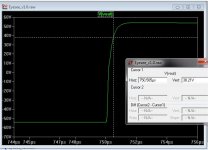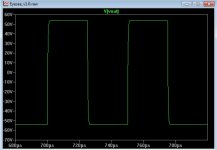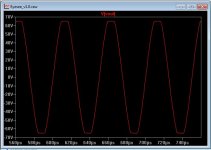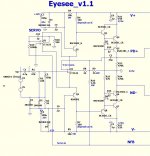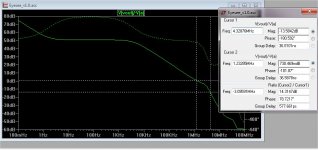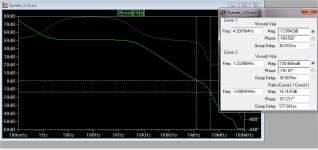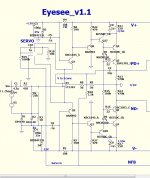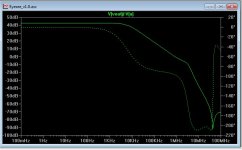... but to be honest I couldn't find a Cordell model for 2SK1058.
The 2SK1056/2SK1057/2SK1058 are all the same except breakdown V.
His model is named 2SK1056.
I checked your profile and it is empty. As far as I know you are just one more...
There is a brief bio. on Jan Didden's Linear Audio website, associated with a couple of articles I wrote, if that makes any difference to you.
But my analysis of the FET models doesn't depend on reputation. There were references and links for anyone to check and confirm.
Wow , the corporate side ...
Very interesting , what is inside these chips determines the end
behavior of the design in general.
I tried a fast LT "300V/us precision op-amp" ....
I got (below 1/2). Nice rounded fast SW's !! 😎
On all my "chip swaps" , the clipping/stability /PM was the same.
1mhz UG /72+ PM ....
The clip is all in the hawksford-superpair (perfect - below 3).
The uninformed fear of IC instability is not an issue here , as the
IC is a unity gain buffer / V-I converter only (not in the compensation loop).
Think of this as a IC based CFA-X/VSSA. The precision manufacturing
of the IC exceeds the discrete anology. You could even have High-
Z FET inputs thrown in as a bonus. 😀 😎
"CFA-XIC" ha ha ....
PS - this could actually be a 76mm X 50mm IPS - tiny .. tiny !!
OS
Very interesting , what is inside these chips determines the end
behavior of the design in general.
I tried a fast LT "300V/us precision op-amp" ....
I got (below 1/2). Nice rounded fast SW's !! 😎
On all my "chip swaps" , the clipping/stability /PM was the same.
1mhz UG /72+ PM ....
The clip is all in the hawksford-superpair (perfect - below 3).
The uninformed fear of IC instability is not an issue here , as the
IC is a unity gain buffer / V-I converter only (not in the compensation loop).
Think of this as a IC based CFA-X/VSSA. The precision manufacturing
of the IC exceeds the discrete anology. You could even have High-
Z FET inputs thrown in as a bonus. 😀 😎
"CFA-XIC" ha ha ....
PS - this could actually be a 76mm X 50mm IPS - tiny .. tiny !!
OS
Attachments
Last edited:
HI OS
Do you have a thread for this amplifier ?
http://www.diyaudio.com/forums/atta...slewmaster-cfa-vs-vfa-rumble-eyesee-draft.jpg
http://www.diyaudio.com/forums/atta...710-slewmaster-cfa-vs-vfa-rumble-eyeseev1.jpg
Thanks
Do you have a thread for this amplifier ?
http://www.diyaudio.com/forums/atta...slewmaster-cfa-vs-vfa-rumble-eyesee-draft.jpg
http://www.diyaudio.com/forums/atta...710-slewmaster-cfa-vs-vfa-rumble-eyeseev1.jpg
Thanks
Last edited:
Should it have a thread ?
It is too "bombed out" simple.
A "toy" amp. A "magnified" IC that can do 150V p-p.
It would always work , I can assure you.
OS
It is too "bombed out" simple.
A "toy" amp. A "magnified" IC that can do 150V p-p.
It would always work , I can assure you.
OS
Should it have a thread ?
It is too "bombed out" simple.
A "toy" amp. A "magnified" IC that can do 150V p-p.
It would always work , I can assure you.
OS
Aah but simple is good! I like simple.
This simple IPS tied a simple LatFET OPS is simply too much for me to resist.
I'll just have to build it.
Aah but simple is good! I like simple.
This simple IPS tied a simple LatFET OPS is simply too much for me to resist.
I'll just have to build it.
(below 1/2) update in schema with a few tips.
With most "cheap" dual OP-amps, 180R -220R is needed for
R6/R7. The current of Vcc/Vee varies between devices.
The ratio of R8/R9 will increase the transconductance of the IC.
The worst (5532) , needs 2X - R8=R9 to give the (below2) 50+db CLG.
Below this gain , thd20 suffers. Bode plot is a typical CFA result , 10K
at the "break-point".
Of the 10+ IC models I have tried , none have oscillated ... some have
given more CLG (almost 60db) . UG has varied from 600K to 1.2mhz.
No PCB yet , before I perfect the circuit. (run more sims) 😀
OS
Attachments
The best thread on diyaudio.com
This is THE BEST thread on diyaudio.com and ostripper has some of the best designs I have seen. Start your own thread about who has the best spice models. Remember,
Spice models, are approximations for non-linear devices. This is a difficult task.
OSTIPPER, we need you on this thread. Your ideas and designs. You are one of the
best on diyaudio.com. Take care.😀
This is THE BEST thread on diyaudio.com and ostripper has some of the best designs I have seen. Start your own thread about who has the best spice models. Remember,
Spice models, are approximations for non-linear devices. This is a difficult task.
OSTIPPER, we need you on this thread. Your ideas and designs. You are one of the
best on diyaudio.com. Take care.😀
Of the 10 IC's you tried, which were the better ones?
Fast ones. like the LT1363. (any that specify 200 -1kV/us)
I'm going to play with the V/I ratio by varying the current FB/voltage gain
ratio (on the IC part of the design).
CLG between 55-65db ( 40+db @ 20K) is the goal. Then ALL the IC's will
be PPM @ THD20.
I will try to "blur the lines" between different devices. This is one of the
reasons for good designs .... device "indifference" 😀 .
OS
Beta enhanced Hawksford. Way to go (below 1).
A. IC dissipation is lower .... not as reliant on (the IC's) transconductance.
Better stability .... not "messing" with the IC as a unity gain follower.
B. 10-12db CLG increase. Better THD20 , even with "cheep chips".
C. Better Bode (below 2) ... with 52db up to 10K and 40db @ 20k.
Just the plot tells me 25ppm thd20.
An amp like the wolverine (blameless) has 110db LF and 50+@20k ,
hence ... 5ppm. 25ppm is not bad for a "cheep chip" 😀
PS - better chips now do <15ppm thd20. (60+db CLG)
OS
A. IC dissipation is lower .... not as reliant on (the IC's) transconductance.
Better stability .... not "messing" with the IC as a unity gain follower.
B. 10-12db CLG increase. Better THD20 , even with "cheep chips".
C. Better Bode (below 2) ... with 52db up to 10K and 40db @ 20k.
Just the plot tells me 25ppm thd20.
An amp like the wolverine (blameless) has 110db LF and 50+@20k ,
hence ... 5ppm. 25ppm is not bad for a "cheep chip" 😀
PS - better chips now do <15ppm thd20. (60+db CLG)
OS
Attachments
Last edited:
Tried the standard CM , wilson CM , with and without the hawksford.
The superpair gives lowest THD / best saturation behavior.
I might take your advice and try a CM/superpair 😎 .
Like the ancient thread .... "power amp under development" 😀 .
OS
The superpair gives lowest THD / best saturation behavior.
I might take your advice and try a CM/superpair 😎 .
Like the ancient thread .... "power amp under development" 😀 .
OS
Tried the standard CM , wilson CM , with and without the hawksford.
The superpair gives lowest THD / best saturation behavior.
I might take your advice and try a CM/superpair 😎 .
Like the ancient thread .... "power amp under development" 😀 .
OS
You don't need to look to far, this one is CM/superpair.
http://www.diyaudio.com/forums/solid-state/253039-unique-cfa-120-230w-amp-2.html#post3866560
You don't need to look to far, this one is CM/superpair.
http://www.diyaudio.com/forums/solid-state/253039-unique-cfa-120-230w-amp-2.html#post3866560
Ohhhh ! a "goldmine" of ideas (I will learn).
But ,
You said it ... 😀for some people too complex I presume
Not for me 🙄 , but the masses like VSSA level ... I'm surprised they
like the "spooky" , with the "busy" PCB and 100 components. 😀
I like it !
what a forum 😱
OS
CM = lost 12db gain (dropped 52 - > 40db) , thd rose from 10ppm to 55.
Need the beta enhancement !
OS
and thermal stability ?
- Home
- Amplifiers
- Solid State
- Slewmaster - CFA vs. VFA "Rumble"
